#konami arcade classics
Explore tagged Tumblr posts
Video
youtube
Experience the RUSH of Konami's Arcade Classics in Their Anniversary Collection!
Games Included:
Scramble TwinBee Gradius (Nemesis) Salamander (Life Force) A-Jax (Typhoon) Haunted Castle Gradius II (Vulcan Venture) Thunder Cross
😎👍👌
8 notes
·
View notes
Text
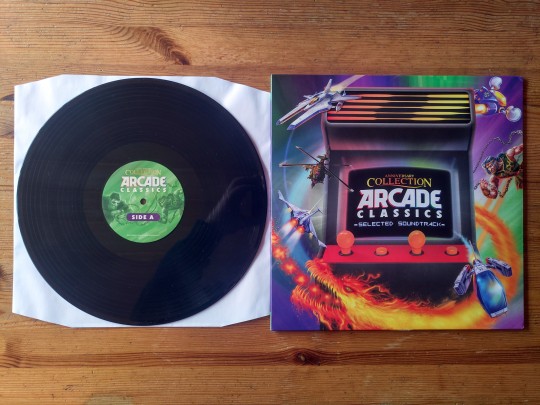
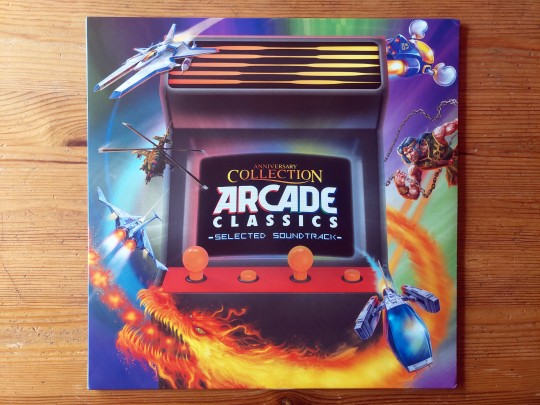
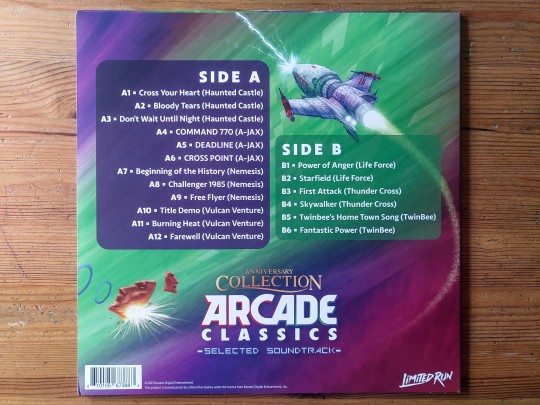
Konami Kukeiha Club - Annivserary Collection: Arcade Classics -Selected Soundtrack- | Limited Run Games | 2023 | Black
#konami kukeiha club#anniversary collection: arcade classics#limited run games#vinyl#black vinyl#lp#music#records#record collection#vgm#video game music#konami#haunted castle#a-jax#gradius#nemesis#vulcan venture#life force#thunder cross#twinbee
9 notes
·
View notes
Text








If there was 1 game that defined my love for space shooters it was definitely Gradius III.
What shooters have you played?
Gradius III, released for the SNES in 1991, is a classic side-scrolling shoot 'em up game that tests players' reflexes and strategic skills. As the pilot of the Vic Viper spacecraft, players must navigate through waves of enemy ships and obstacles, upgrading their weapons and abilities along the way to face off against powerful bosses. With its challenging gameplay, stunning visuals, & iconic power-up system, Gradius III remains a beloved title in the shoot 'em up genre, offering intense action & nostalgia for fans of retro gaming.
#16bit#classic games#gamer#nintendo#pixel art#retro#retro gaming#retrogaming#snes#super nintendo#nintnedo#gradius#gradius iii#gradiusiii#shmups#shooters#arcade games#arcade#konami#side scroller#action#adventure#space shooter#space#retro games#classic#classics#old school#old school gaming#retro graphics
3 notes
·
View notes
Text
Ninja Armageddon! Arcade Archives Mystic Warriors Blasts Onto Switch and PS4 Today
There’s a new ninja brawl in town, and it’s ready to take you back to the glory days of 16-bit side-scrolling mayhem. Yes, the legendary Arcade Archives Mystic Warriors has finally thrown its shurikens onto the Nintendo Switch and PlayStation 4, bringing a heaping dose of nostalgic beat-’em-up action straight from 1993. Dust off your headband and sharpen your kunai, because in Mystic Warriors,…

View On WordPress
#16-bit#action-adventure#adjustable difficulty#affordable#Arcade Archives#arcade game#beat-&039;em-up#classic gaming#December 2023 release#hidden gem#Konami#multiplayer#ninja game#nintendo switch#online high scores#pixelated graphics#PlayStation 4#retro game#rewind#side-scrolling
2 notes
·
View notes
Text
Frogger Leaps To Video Game Hall of Fame Finals—Will It Make the Jump?
I can’t believe my pixelated eyes—Frogger is just now a finalist for the World Video Game Hall of Fame. I could’ve sworn this game had already hopped in ages ago! This arcade classic has been leaping through pop culture for decades, most famously in that Seinfeld episode where George Costanza tries to save his legendary high score from a doomed pizzeria. Spoiler alert: much like an unlucky frog…
#1980s video games#arcade legends#best arcade games#Classic arcade games#classic games#Frogger#Frogger high score#Frogger nomination#Frogger Seinfeld episode#Frogger soundtrack#Frogger world record#George Costanza Frogger#Hall of Fame video games#Konami games#retro gaming#Seinfeld Frogger#video game culture#video game history#World Video Game Hall of Fame
0 notes
Video
youtube
Handheld Fighting Games of 89/94 - Raging Fighter
Raging Fighter is a one-on-one martial arts fighting game released in 1993 for the Game Boy by Konami. Set in the futuristic Omega League, the game pits seven unique fighters against each other in a quest to determine the universe's ultimate champion. Each fighter boasts distinct stats such as speed and defence, along with two special attacks activated by precise button combinations.
The game offers several modes, including Story Mode, where players progress through the tournament, and Training Mode, which allows practice against a stationary opponent. Additionally, Tournament and Multiplayer modes offer competitive experiences, with the latter supporting two players via a link cable. Matches follow a best-of-three format, with victory achieved by depleting the opponent’s health or outlasting them within the time limit.
1. Intro 00:00 2. Gameplay 00:15 3. Outro 05:22
For other Handheld Fighting games released between 1989 and 1994 check out this playlist. https://www.youtube.com/playlist?list=PLFJOZYl1h1CG_uI1-iafuDaV2LXRQTbZH
#youtube#game boy#konami#retro arcade#1990s gaming#handheld games#fighting games#martial arts#omega league#retro gamers#classic gaming#video game history#raging fighter#game boy fighting games#retro gameplay#gaming nostalgia#retro gaming community#retro games#classic games#90s games#90s gaming
0 notes
Text
youtube
Classic Game of the Week: Metamorphic Force Developer: Konami Publisher: Konami Platforms: Arcade Video Courtesy of: NintendoComplete
#classic game of the week#classic game#classic gaming#arcade#konami#arcade game#sidescroller#side scroller#beat em up#bemani#Youtube
1 note
·
View note
Text

Episode 68 - Yes, I'm An Arcade Employee
Greetings, and welcome to Episode 68! In this one, Brian discusses a game he discovered in 1993, breaks down another home system, and wraps things up with some thoughts from the road after his second day working at an arcade.
If you would like to contact the show, you can send an email at [email protected] or you can leave a voicemail for the show at 734-632-0832. The show also has a Facebook page (www.facebook.com/arcadeaddictbrian), and is also on Instagram (@arcadeaddictbrian), Bluesky (@arcadeaddictbrian.bsky.social) and Tumblr (tumblr.com/confessionsofanarcadeaddict). You can help the show by leaving a five-star review wherever you listen to it, which helps other people find it. If you want to help the show directly, go to https://podcasters.spotify.com/pod/show/coaa and click on the Donate button. For as little as a dollar a month, you can help the show develop further as a podcast, as Brian uses those funds for things directly related to the show such as buying podcasting equipment, and funding arcade runs to new locations for him to review for the show.
And now, I’m streaming live on Twitch! Twitch.tv/arcadeaddictbrian. If you��re a listener to the show, please do me a solid and drop me a follow over there. That helps grow the stream, and who knows, maybe I might become a big-time streamer! A guy can hope, right??
Discord server coming soon!
Hope to hear from you soon, and good gaming out there!
RSS Feed: https://anchor.fm/s/4481fd0/podcast/rss
Are You Experienced? – Run and Gun
Home Systems – Magnavox Odyssey 2
On The Road – June 26th, 2021: Second day of work at The Arcade
#spotifypodcast#confessionsofanarcadeaddict#coaa#classic video games#arcades#konami#run and gun#magnavox#odyssey2#on the road#2nd day#job number 4
1 note
·
View note
Text

The X-Men in a Sideshow art print by Jhony Caballero (2024) based on Konami’s all-time classic X-Men: The Arcade Game (1992)
#marvel comics#marvel video games#x-men#uncanny x-men#x-men: the arcade game#sideshow collectibles#jhony caballero#x-men video games#marvel 1990s#marvel 1992#marvel 2024
142 notes
·
View notes
Text









DDR 5th Mix stimboard with themes of arcades, rhythm games, and classic games! (I have no credits to give except to Konami for creating DDR, I recorded all of these GIFs. You have permission to use these gifs as long as you credit me)
#stimboard#arcade games#retro gaming#arcades#arcade stimboard#ddr stimboard#dance dance revolution#dance dance revolution 5th mix#ddr 5th mix#ddr#dance dance revolution stimboard#rhythm games#rhythm game stimboard#nostalgia#nostalgia stimboard
127 notes
·
View notes
Text

Ah, the glorious history of SHMUPs (shoot 'em ups)! Buckle up as we take a nostalgic trip through the evolution of this exhilarating genre.
Early Beginnings
The SHMUP genre's roots can be traced back to the late 1970s and early 1980s. The concept was simple yet addictive: control a spaceship or character and shoot waves of enemies while dodging their attacks.
Space Invaders (1978) by Taito was a groundbreaking title that laid the foundation. Its straightforward gameplay—defending the Earth from descending alien invaders—captivated players and became a cultural phenomenon. The success of "Space Invaders" sparked a wave of similar games and established the basic mechanics of SHMUPs.
Galaxian (1979) by Namco took the formula further by introducing more dynamic enemy patterns and colorful graphics. This was followed by Galaga (1981), which added new features like enemy formations and the ability to rescue captured fighters, enhancing both strategy and excitement.
The Golden Age
The early 1980s saw a surge of creativity and innovation in SHMUPs. Games became more complex, with varied enemy behaviors, power-ups, and improved graphics.
Xevious (1982) by Namco introduced a scrolling background and multi-layered gameplay, with enemies attacking from both the air and ground. This was a significant step towards the more complex SHMUPs of later years.
Gradius (1985) by Konami was another landmark title. It introduced the "power-up bar" system, where players could collect power-ups and choose their upgrades strategically. The game's intricate level design and memorable boss battles set a new standard for the genre.
R-Type (1987) by Irem pushed the envelope with its detailed graphics, unique power-up system, and iconic "force" orb that added a layer of tactical depth. Its challenging gameplay and creative enemy designs made it a classic.
The 16-bit Era
The late 1980s and early 1990s were a golden era for SHMUPs, with the arrival of 16-bit consoles like the Sega Genesis and Super Nintendo Entertainment System (SNES). These platforms allowed for more sophisticated graphics and sound, leading to some of the most beloved titles in the genre.
Thunder Force IV (1992) by Technosoft was a standout, featuring stunning visuals, a dynamic soundtrack, and fast-paced gameplay. Its multiple weapon systems and large, sprawling levels were a treat for SHMUP fans.
Axelay (1992) by Konami showcased the SNES's graphical capabilities with its Mode 7 effects, offering both vertical and horizontal scrolling levels. The game's innovative weapon system and detailed graphics made it a standout.
The Bullet Hell Revolution
The mid-90s brought a subgenre of SHMUPs known as "bullet hell" or "danmaku," characterized by overwhelming enemy fire patterns that required precise dodging and memorization.
DonPachi (1995) and DoDonPachi (1997) by Cave were pioneers of this style. They emphasized intricate bullet patterns, high difficulty, and scoring systems that rewarded skillful play. These games pushed players to their limits and became cult classics.
Modern SHMUPs: Nostalgia and Innovation
While SHMUPs have become more niche in the mainstream gaming market, they continue to thrive in arcades and among dedicated fans. Modern titles often blend retro aesthetics with contemporary design sensibilities.
Ikaruga (2001) by Treasure is a prime example. Its unique polarity-switching mechanic, where players can absorb bullets of the same color as their ship, added a strategic layer to the traditional SHMUP gameplay. The game's striking visuals and challenging gameplay earned it widespread acclaim.
Mushihimesama (2004) and other titles by Cave continue to push the boundaries of the bullet hell genre, with increasingly complex patterns and high production values.
The Indie Revival: A New Generation
In recent years, the indie game scene has embraced SHMUPs, bringing fresh ideas and styles to the genre. Games like Jamestown: Legend of the Lost Colony (2011) combine classic SHMUP mechanics with modern graphics and storytelling.
The accessibility of modern development tools has allowed small teams and solo developers to create innovative SHMUPs, ensuring that the genre remains vibrant and diverse.
A Timeless Genre
The history of SHMUPs is a testament to the genre's enduring appeal. From the simple yet addictive gameplay of "Space Invaders" to the intricate bullet patterns of "DoDonPachi," SHMUPs have continually evolved, challenging and delighting players for decades. The genre's focus on skill, reflexes, and high scores ensures it will always have a place in the hearts of gamers, both old and new.
#SHMUPs#Shoot 'em ups#Space Invaders#Galaxian#Xevious#Gradius#R-Type#Thunder Force IV#Axelay#bullet hell#danmaku#DonPachi#DoDonPachi#Ikaruga#Mushihimesama#Legend of the Lost Colony#Retro#Gaming#Pixel Crisis
12 notes
·
View notes
Text

Top 47K - Pepsiman + Devil World
Join the HG101 gang as they discuss and rank the cult classic PS1 advert-game about the man who spreads awareness of Pepsi. Then stick around, because our SUMMER ARCADE FEATURE continues with Konami’s otherworldly Gauntlet clone!
#pepsiman#pepsi#KID#playstation#action games#devil world#konami#arcade#action adventure#hardcore gaming 101#podcast#top 47858 games of all time#video games#retro games
10 notes
·
View notes
Text
youtube
Frogger stands as one of the defining arcade classics from the early 1980s. Konami's 1981 creation puts players in control of a frog attempting to navigate both a treacherous highway and a hazardous waterway to reach safety.
The original cabinet version challenged gamers to steer their hoppy protagonist across five busy traffic lanes while avoiding an assortment of vehicles. After surviving this gauntlet, players then had to traverse a dangerous river by leaping onto drifting logs, turtles, and other floating platforms without plunging into the current.
Success meant guiding five of these frogs to their lily pad homes at the screen's top before time expired. This straightforward concept paired with demanding gameplay turned Frogger into an immediate success, spawning countless adaptations across numerous gaming platforms over the decades.
Nintendo's portable take arrived in 1991, ten years after the arcade original. Published by Konami, this pocket-sized rendition delivered a surprisingly faithful experience despite the Game Boy's technical constraints. The monochrome visuals translate remarkably well to the handheld's display, with crisp graphics that preserve the essence of its source material. The audio elements were also thoughtfully adapted to the portable's sound capabilities.
It's wild to think that 34 years after this handheld iteration came out, it's still so much fun to play.Though lacking the vibrant colors of its arcade parent, it perfectly captures what made the original tick. The responsive controls prove essential when making those crucial split-second hops through traffic. Most impressive is how the developers maintained the title's challenge factor despite the more compact display. I found myself experiencing the same mixture of frustration and addiction that characterized my sessions with the arcade machine.
In my view, this pocket-sized adaptation stands as an exemplary translation of Frogger. For a 1991 Game Boy title, it's aged remarkably well, ranking among the more successful arcade-to-portable conversions from that period.
The enduring appeal of Frogger has spawned countless follow-ups, reimaginings, and modern interpretations across gaming generations, securing its position among the most instantly recognizable arcade classics in video game history.
#retro gaming#retro gamer#retro games#video games#gaming#old school gaming#old gamer#gaming videos#youtube video#longplay#frogger#game boy#handheld gaming#action games#love gaming#gaming life#gamer for ever#gamer for life#gamer guy#gaming community#Youtube
2 notes
·
View notes
Text
Mystical Ninja Starring Goemon
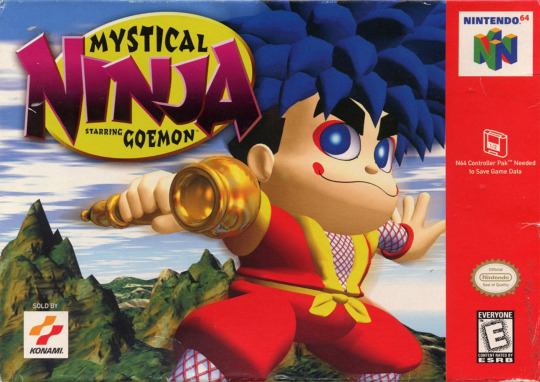
JP release: 7st August 1997
NA release: 16th April 1998
PAL release: 18th April 1998
Developer: Konami
Publisher: Konami
N64 Magazine Score: 90%

I remember seeing the scores for Mystical Ninja in N64 magazine, but it didn’t seem like my kind of game. I was very wrong about that – Goemon’s first N64 game is kind of a hybrid of Super Mario 64 and Ocarina of Time, mixed with edo era Japan and a gloriously absurd plot of musical performers trying to turn Japan into their stage.
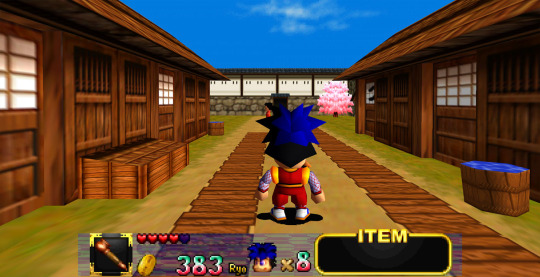
The game starts out in a Zelda-style town, but what’s impressive is that this is from before Ocarina of Time. You can swap between Goemon and Ebisumaru (plus more you meet along the way) at any time, each with their own set of weapons and abilities. These are uses sparingly throughout the game, so for the most part you can play as who you prefer.
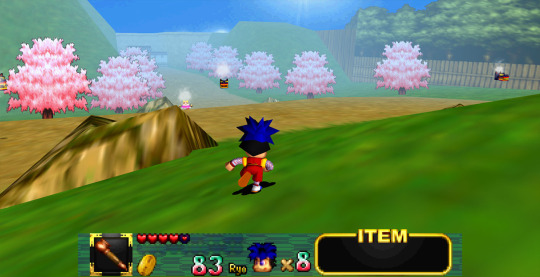
Connecting each town is a large overworld with some nice locations. The first one I encountered brought back strong childhood memories as I recognised the music from Krazy Konami Racers, but the rest of the music in the game is also great, with lots of great tracks throughout the game. I was bopping my head to quite a lot of the music which mixes classical and modern instrument sounds.

Dungeons also play a big part in the game. While there are map/compass items to collect and keys to find, they’re a lot more platform-oriented than Zelda dungeons. One downside is the game’s camera (which can be turned holding R and using the c-buttons), but it’s something you get used to. While there are some bottomless pits, other areas just have you fall to a section where you work your way back – although one handy thing is that there’s no fall damage.
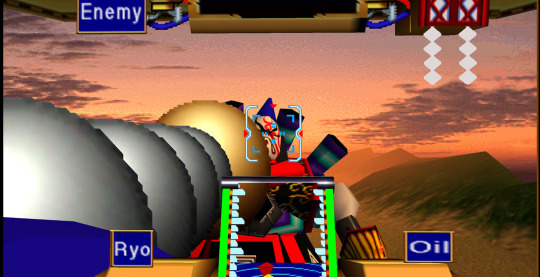
There’s also a variety of other sections, including multiple giant robot boss fights, which treat you to a song each time you use your giant robot, Impact. Each starts off with an arcade-style section to build up your health and ammo before taking a first person perspective as you shoot and punch your opponent. It’s a lot of fun, although they do become more frustrating the longer they go on.
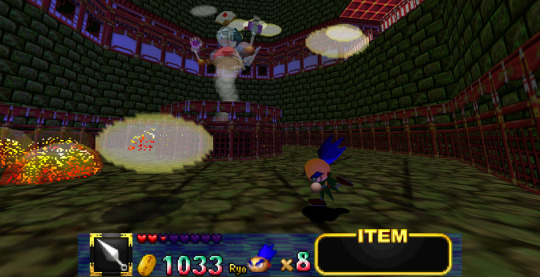
Goemon is an incredibly charming game that’s still a ton of fun to play. Some of the puzzles do have a sign flat out telling you what to do, although these mainly relate to Ebisumaru’s camera item, which reveals hidden things, so I would probably get stuck without being reminded that the object exists. Even with that, the main story is amusingly silly and the game likes throwing new things at you. It’s a great game.
It’s a clever game, not only because there’s simply so much to do, but because you’re never quite sure what’s going to come next. Mini boss? End-of-level boss? Ludicrous sub-game involving a big yellow man and some falling shrinking pills? Erm, yes, quite. Mystical Ninja is a supreme example of game invention.
- Tim Weaver, N64 Magazine #14
Remake or remaster?
An updated version of Mystical Ninja would be great, with a better camera and fine tuned controls. A bit of extra side content would also be welcome. And perhaps a quest log as instructions are a but unclear at times.
Official ways to get the game.
There is no official way to get Mystical Ninja Starring Goemon.
14 notes
·
View notes
Text
Its that time again! My list of played games in 2024!!
2024 Games List (Dates= Day/Month)
1.Chu Chu Rocket (GBA, Normal puzzles) (7/1) 2.World of Illusion starring Mickey Mouse and Donald Duck (Genesis, 4/2) 3.Star Fox 2 (SNES mini, 4/2) 4.Castlevania Bloodlines (Genesis, 5/2) 5.DARIUSBURST (PSP, 22/2) 6.Pikmin: New Play Control! (Wii, 29/2) 7.Trauma Center: Under the Knife 2 (DS, 29/2) 8.Super Galdelic Hour (PS2, 7/3) 9.Crush (PSP, 8/3) 10.Batsugun (Bitwave, PC, 2024) (10/3) 11.METAFIGHT (Famicom, Eng Translated) (15/3) 12.Another World: 20th Anniversary (PC, 18/3) 13.Ninja Gaiden (NES, 22/3) 14.Ninja Gaiden 2 (NES, 23/3) 15.The Legend of Zelda: Majora's Mask 3D (3DS, 27/3) 16.Flower, Sun and Rain (DS, 30/3) (Replay) 17.Monster Hunter 4 ULTIMATE (3DS, 5/4) (Caravan Ending (Low Rank) at G1) 18.No More Heroes 2: Desperate Struggle (PC, 10/4) (Replay) 19.Rhythm Thief & the Emperor’s Treasure (3DS, 18/4) (Replay) 20.Sin & Punishment (N64, 25/4)(Normal)(Replay) 21.Mischief Makers (N64, 27/4) 22.Gurumin: A Monstrous Adventure (PC, 6/5) 23.Panzer Dragoon (Saturn, 10/5) 24.Panzer Dragoon II Zwei (Saturn, 11/5) 25.Yo-Kai Watch 3 (3DS, 19/5)(Replay) 26.Panzer Dragoon Saga (Saturn, 14/6) 27.Devil Blade REBOOT (PC, 16/6) (HBD 2 ME) 28.Moero! Nekketsu Rhythm Damashii Osu! Tatakae! Ouendan 2 (DS, 24/6) 29.Viewtiful Joe (GC, 26/6) 30.We Love Katamari REROLL + Royal Reverie (PC, 30/6) 31.Mr.Driller Drill Land (GC, 30/6) 32.Viewtiful Joe (GC, 30/6)(Replay) 33.The Wonderful 101: Remastered (PC, 14/7)(Replay) 34.Sonic The Hedgehog 3 & Knuckles (Genesis, 28/7) 35.Metal Gear Solid 3: Snake Eater - HD Edition (PC, 4/8)(Replay, Euro Extreme, FOXHOUND) 36.Typing of the Dead (Dreamcast, 4/8) (Technically replay) (First full clear) 37.Sonic Mania: Plus (PC, 10/8)(Mania Mode) 38.Konami Classic Series: Arcade Hits (DS, 11/8)(Havent completed everything but its good) 39.Sega Bass Fishing/Uchi Tsuri Bass Fishing (Wii, 25/8)(Arcade courses cleared) 40.Hotel Dusk: Room 215 (DS, 27/8) 41.Sonic Adventure 2: Battle (PC, 12/8)(Replay) 42.Resident Evil: Deadly Silence (DS, 18/8)(Replay)(My First Chris Run) 43.Resident Evil: Deadly Silence (DS, 19/8)(Replay)(2:36:05 Chris, 3 Saves) 44.Super Mario 3D World (Wii U, 20/9) 45.Castlevania: Symphony of the Night (PS1, 29/9)(Bad End) 46.Castlevania: Portrait of Ruin (DS, 8/10)(Good End, 1000%) 47.Michigan: Report from Hell (PS2, 11/10) 48.Travis Strikes Again: No More Heroes Complete Edition (PC, 18/10) 49.Wave Race 64 (Wii,22/10)(Normal)(Replay) 50.ICO HD (PS3, 23/10) 51.Resident Evil: Deadly Silence (DS, EMU ,25/10)(Replay) (Chris) 52.Sonic Colors (Wii, Real Hardware, 29/10)(Replay) 53.Resident Evil 4 HD (PC, 29/10)(Replay) 54.REZ INFINITE (PC, 31/10)(original, w/trance vibrator on) 55.Radirgy Swag (Switch, 6/11)(4th Attempt, Clear)(10m32s, 384400km, 0138011200pts) 56.G-DARIUS HD (PC, 9/11)(Replay)(Co-op, no 1cc) 57.No More Heroes 2: Desperate Struggle (Wii (RH), 13/11)(Replay) 58.Radirgy 2 (Switch, 19/11)(Both Ships) 59.Radirgy 2 (Switch, 20/11)(Replay)(1CC, Murasame) 60.Astro Ninja Man DX (NES, 22/5)(1cc, forgot to include it till now) 61.The Silver Case (PC, 7/12) 62.Rhyme Rider Kerorican (Wonderswan, 12/12) 63.Bloodstained: Ritual of the Moon (PC, 14/12) 64.Bloodstained: Curse of the Moon (3DS, 15/12) 65.Um Jammer Lammy (PS Vita, 30/12)(replay) 66.Gitaroo Man Lives! (PSP(Through vita), 29/12)(replay) 67.Sonic the Hedgehog 2 3D (3DS, 31/12)(Replay)
Yahoo! thats alot of games! less than 2023 but its not about the count but the times had. this year ill mess arround with more RPGs!! I didnt play alot of em last year haha
3 notes
·
View notes
Text
Sony PlayStation - Castlevania Chronicle Akumajo Dracula (Castlevania Chronicles)
Title: Castlevania Chronicle Akumajo Dracula / 悪魔城年代記 悪魔城ドラキュラ
Developer/Publisher: Konami Computer Entertainment Tokyo
Release date: 25 May 2001
Catalogue No.: VX236-J1 / SLPM-86754
Genre: Action


This game is basically a home console port of the Sharp X68000 entry in the Castlevania series. The plot of Castlevania Chronicle is similar to that of the first Castlevania: at the end of the 17th century, the dreadful vampire Dracula is resurrected after a century of slumber. The people in Transylvania flee in horror, but the brave Simon Belmont takes his Vampire Killer whip and ventures into the ominous castle to put an end to the Lord of Darkness. This is the exact same plot as found in the Sharp X68000 original.
When it comes to graphics, I feel I must be honest. These graphics are fairly average, especially for a game released on a platform supposedly capable of arcade-quality graphics, and in 1993 no less. I would say Simon and other sprites, backgrounds, etc. are probably about the same quality as Castlevania Bloodlines. Not bad, but one must always consider the hardware when reviewing. Many arcade ports were lacking on the X68000, but certainly closer to arcade graphics than this version of Castlevania, which looks like an early Mega Drive effort. Think Alex Kidd in the Enchanted Castle.
Aside from that rant, the familiar-looking Castlevania stages have all been redone, and look definitely better detail-wise, compared to the FDS and Famicom original that kickstarted the series, so at least we can acknowledge them as upgrades. Simon's sprite is certainly different looking as well and it is nice to see the slight redrawn changes of Dracula, Death, and other famous bosses and enemies. The crystal man in Stage 4 sucks ass though. I don't care for his appearance at all, it seems so out of place!
On the bright side, there are many classic Castlevania tunes redone for this release, which include Bloody Tears, Vampire Killer, and Simon's Theme. Exclusive pieces (due to the stages not being present in the MSX, NES, or myriad other versions of the original Castlevania) include Tower of Dolls and Etude for the Killer, both solid compositions that earn their place among CV music. Lastly, Dracula's boss music, while it can't touch Super Castlevania IV (aka Akumajo Dracula on the Super Famicom), is awesome simply because of its name: You Goddamned Bathead! Classic! The gameplay has several changes from the original versions of Castlevania. Simon can whip diagonally down left or right while jumping. He is also able to slightly correct his jumps in mid-air, saving you some unnecessary deaths. We also have a new subweapon that helps to conquer the notorious difficulty of this remake. This is a laurel/herb and for 10 hearts, you can refill 6 life bars. A very helpful and neat idea, proving that the game is not without rules.
The challenge is merciless; this is the hardest traditional Castlevania there is, mostly due to the huge amount of damage that enemies take off with each hit. In the early stages, it is only 2 or so bars. In the later stages, every single attack does 4 bars, causing Simon to die in only 5 hits. This coupled with the still limited dodging and mobility of Simon makes having the aforementioned laurel seem like a necessity if you want to beat this game without a great deal of frustration. The laurel certainly helped me to do as such.
Now you might say that this was the case in the FDS and Famicom Castlevania too. Still, this is an ultimately harder game because of the new enemies and stages. Many more enemies have projectiles that they use to hit you from far away. The dolls in Area 7 are especially annoying, all this adds up to a deeper and greater challenge. Replay value for this specific game is no more significant than the original. There is the added challenge of new enemies and greater incurred damage for each subsequent playthrough, but that cannot be defined as a true incentive to replay as the stages and bosses are identical. The only real difference is that enemies hit harder and that there are more of them.
In conclusion, Castlevania X68000 was mostly unknown at the time of its release, and in playing this, I'm glad it has received greater availability on the PlayStation. There are minor differences in the PS1 version mostly involving the internal system clock option affecting certain stages and graphics, nothing to really write home about.
I try to look at this remake in the context of a Japan-only release or the 1993 release year, but neither bit of reflection gives this product much reason to exist, especially as a far superior remake of Castlevania had already been made in Akumajo Dracula on the Super Famicom. That remake was on a far superior and more accessible system. Perhaps this X68000 version was nothing more than an attempt to sell the Sharp computer (which was sold at super expensive prices with prices starting from US$3,500 for the base configuration) by putting respected franchises on it, similar to the Mario and Zelda games on the Phillips CDi, and we all know how bad those games turned out. Castlevania X68000 is not as bad as those games, it is at least playable, but it feels like an unclear project. Given the PC's limited user base, who was this game meant to appeal to? It is worth a playthrough on the PlayStation version, but I can't fathom the complete sense that would make a gamer hardcore enough to buy the Sharp PC just to play this fairly mediocre remake of the original Castlevania. The limited new features of this version just don't do enough for me.
However, all this pales in comparison to the fact Konami actually added an Arrange Mode to the PlayStation port. Castlevania Chronicle's arrange mode is all about the little changes that may not be initially apparent. It really feels like it was made for the fans, as these are the groups likely to enjoy the changes the most. These are both obvious with the complete musical overhaul and subtle with the slight graphical changes. I think the best way to express my approval is to say that the Arrange Mode not only makes the Sharp X68000 version better, but it also makes it more acceptable as part of the Castlevania series.


youtube
youtube
2 notes
·
View notes